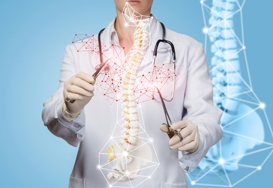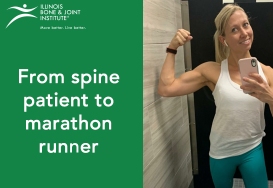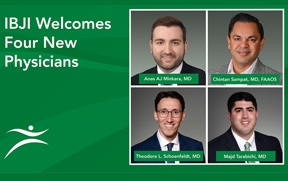Feeling pain in your foot is common and can have many different causes, but can a back problem cause foot pain?
Foot pain is often a result of injury, wearing ill-fitting shoes, or physical issues within the foot, such as tendonitis, arthritis, or bursitis. However, in some cases, pain in your foot may be linked to problems in your spine.
Keep reading to learn about some back problems known to cause foot pain and what causes them.
Spinal Conditions That Cause Pain in Feet
Even if you don’t have back pain, you may still have a spine condition that causes you to feel discomfort elsewhere in your body, like your feet.
There are some revealing signs of foot pain caused by a problem in your spine, such as your foot feeling heavy, difficulty raising your foot, leg pain, numbness, weakness, and trouble walking on your tiptoes.
Studies have shown that spinal dysfunction, like a spinal canal narrowing or spinal stenosis, pinches and squeezes on the spinal nerves in your lower back, causing leg pain that radiates down to your feet.
The kind of pain felt depends on the location of the spinal dysfunction. For instance, a problematic L3–L4 spinal area would cause pain in the front of the thigh, the frontal area of the knee, the shin, or the foot.
If you suspect your foot pain may be due to a spinal issue, you should discuss the spinal dysfunctions with your physician. After an initial medical checkup, your physician may direct you to a spine specialist who knows how to find for further examination.
So, if you’ve ever wondered, “Can a back problem cause foot pain?” The simple answer is yes, spine issues result in feelings of foot pain. Here are some of the specific spinal conditions that can cause feet pain include:
- Herniated Discs
- Sciatica (Radiculopathy)
- Degenerative Spondylolisthesis
- Facet Joint Arthritis
Herniated Discs
There may be a variety of spinal disc problems, like a torn disc, slipped disc, disc protrusion, or collapsed disc that could lead to associated pain, and such pathologies are often used interchangeably or sometimes referred to separately as a herniated or bulging disc.
With a herniated disc, more often, it is not the disc itself that is painful but rather the leaking inner disc fluid that irritates a nearby nerve, causing radicular or nerve root pain.
This radicular pain from the pinched nerve may travel from the lower back to other parts of the body, such as down the leg or arm. When the leg or foot pain is a direct result of problems in the disc space itself, the patient is said to have a degenerated disc, which typically causes axial pain.
Sciatica (Radiculopathy)
The five sciatic nerves join at the base of the spine and extend down the back of each leg to the toes. The sciatic nerves connect the spinal cord to many muscles in the leg and foot.
When the sciatic nerves become irritated from any associated lower back problem, which pinches on the nerve roots, instead of back pain, it may cause leg and foot pain commonly referred to as sciatica, or radiculopathy.
Degenerative Spondylolisthesis
Degenerative spondylolisthesis is a low back condition commonly occurring in people over age 65 because of a slipped vertebral body that goes forward over the one below it.
Degenerative spondylolisthesis typically occurs at either the L4–L5 level of the lower spine or the L3-L4 level of the lumbar spine. It rarely develops at other spine levels but may take hold simultaneously at two or even three levels.
This condition results from aging, where the spinal bones, joints, and ligaments become weakened and unable to hold together the alignment of the spinal column. When the vertebra slips, it compromises the spine segment. It also leads to a pinched nerve that radiates pain down the leg and into the foot.
Facet Joint Arthritis
Arthritis is an inflammation of the joint that causes symptoms such as pain, tenderness, swelling, and stiffness, finally leading to soft tissue damage in the body. Physical disabilities from various forms of arthritis affect the lives of over 50 million people in the United States.
Unlike the general perception, arthritis is not just an age-related disease. It also causes distress to nearly a half million children too.
Osteoarthritis is the most common form of disabling and painful arthritis that affects the joints of the weight-bearing bones—such as the hips and knees—as well as those of the spine, hands, and feet.
With time, small bony growths (or osteophytes) form on the facet joints and around the vertebrae as a response to joint instability. But the formation of these osteophytes further destabilizes the spine and causes further pain.
The bone spurs enlarge and cut further into the space for the nerves to pass, called spinal stenosis, prodding and entrapping the nerves passing through the spinal structure. This pain can radiate down from the spine to the foot and leg.
Getting a proper diagnosis from a spine specialist is advisable to find the specific potential lower back conditions that may be causing your foot pain.
Get Relief From Pain with IBJI
Can a back problem cause foot pain? Yes, and the experts at IBJI can help get to the bottom of what’s causing your pain. Schedule online with an IBJI orthopedic specialist today.
You Might Also Like:
- Considering Back Surgery? Here Are the Top Procedures for Back Pain Relief
- Cervical Fusion Surgery – Types of Cervical Fusion, Procedure, and Recovery
- Patient Story: Spine Surgery Recovery Time (Chad F.)
*This content is for information only and is not intended to replace the diagnosis, treatment, or medical advice from your treating healthcare professionals. The content does not provide medical advice, does not constitute the practice of medicine or other healthcare professional services, and does not create a doctor-patient relationship. You should not rely on this information as a substitute, nor does it replace professional medical advice, diagnosis, or treatment. If you have concerns or questions, seek the advice of your healthcare professionals. If you think you may have a medical emergency, call your doctor or 911 immediately. Do not rely on electronic communications or communicate through this website for immediate, urgent medical needs. This website is not designed to facilitate medical emergencies. The use of the information is at the reader’s own risk. The links are provided for information and convenience only. We cannot accept responsibility for the sites linked or the information found here. A link does not imply an endorsement of a site.





